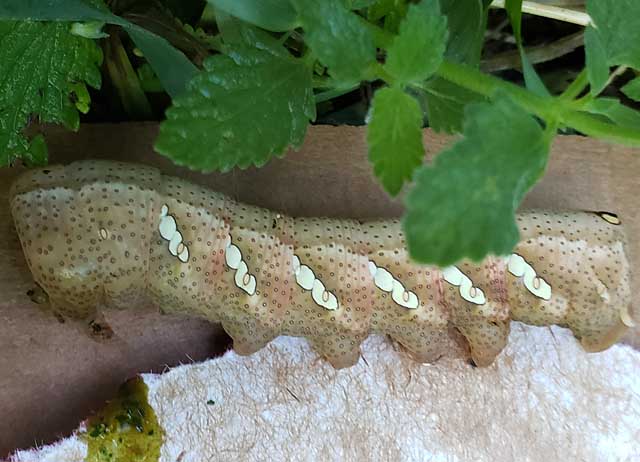Sphinginae subfamily
Sphingini tribe:
 |
Ceratomia amyntor
WO/Custer,
the Elm Sphinx or Four-horned Sphinx
Larvae feed on Elm (Ulmus), birch (Betula), basswood
(Tilia), and cherry (Prunus).
There are both green and brown forms. The four horns near
the head are diagnostic. |
 |
Ceratomia undulosa
WO/Pennington/Haakon, the Waved
Sphinx
Fraxinus, Ligustrum, Quercus, Crataegus and
Chionanthus virginicus are listed as hosts.
In the fifth instar, the spiracular ovals are decidedly red and the
anal horn is off-white to pinkish laterally.
|
 |
Manduca quinquemaculatus
WO/Pennington/Jackson,
the Five-spotted Hawkmoth
The caterpillars are called Tomato Hornworms and each has a black horn at the end of the abdomen.
Larvae feed on potato, tobacco, tomato, and other plants in the
nightshade family (Solanaceae).
|
 |
Sphinx chersis
WO/Custer, the Northern Ash Sphinx or Great Ash
Sphinx:
The larvae are pale bluish green. The head has a pair of yellow
lateral bands meeting at the apex. The oblique, lateral stripes are
pale and bordered anteriorly with a darker green.
Larval hosts are ash, lilac, privet, cherry, and quaking aspen.
|
 |
Sphinx drupiferarum WO, the Wild Cherry Sphinx.
Larvae hide in the day and feed primarily on cherry, plum, and apple
at night. Larvae have been found on Amelanchier nantuckensis
in Massachusetts and have been reared to pupation in Michigan on
Prunus serotina. Note purple oblique lines.
|
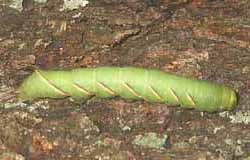 |
Sphinx luscitiosa
WO, the Canadian Sphinx or Clemen's Sphinx.
Larval hosts are willow (Salix), poplar (Populus), birch (Betula), apple (Malus), ash (Fraxinus), waxmyrtle (Morella), and northern bayberry.
|
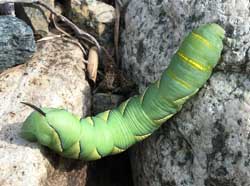 |
Sphinx vashti
WO/Pennington/Bennett/Custer/Shannon,
the Snowberry Sphinx
Larvae feed on the common snowberry (Symphoricarpos albus)
and on coralberry (S. orbiculatus). Note the two golden
lines of slightly raised bumps, one just behind the head, the other
on the thorax.
|
Smerinthini Tribe:
 |
Amorpha juglandis
WO?? generally more eastery,
the Walnut Sphinx
Amorpha juglandis larvae feed upon Walnut and butternut (Juglans),
hickory (Carya), alder (Alnus), beech (Fagus),
hazelnut (Corylus), and hop-hornbeam (Ostrya).
|
 |
Pachysphinx modesta
WO/Haakon,
the Modest Sphinx or Poplar Sphinx
Larvae feed on poplars and cottonwood.
|
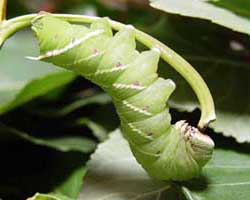 |
Pachysphinx occidentalis;
Big Poplar Sphinx; Modest Sphinx or Poplar Sphinx; Pennington;
Larvae feed on cottonwood and poplar (Populus) and willow
(Salix). Larvae are very chunky with little to distinguish them from Pachysphinx modesta.
|
 |
Larvae accept willows, birches, and cherries.
I have also found them in the wild on oak in eastern Canada.
|
 |
Paonias myops WO/Custer/Haakon/Jackson,
the Small-eyed Sphinx
Wild cherry species are the favorites as larval foodplants, but eggs
will also be deposited on birches and other forest trees.
There are varying degrees in the amount of red markings along the sides.
|
 |
Larvae feed upon many forest trees including birches and cherries,
but are expecially fond of poplars and willows. Red markings on sides
vary greatly from specimen to specimen.
|
 |
Smerinthus cerisyi
WO/Pennington/Custer,
Cerisy's Sphinx;
Cerisyi larvae greatly resemble modesta larvae, both being pale
green, with granular skin, pale lateral diagonal lines, faint red
spiracular circles, and very pale longitudinal lines running from the
head to a more pronounced anal diagonal line.
Larvae have green heads bounded dorsally with a pale yellow
inverted "V".
|
Macroglossinae subfamily
Dilophonotini tribe:
 |
Hemaris thysbe
WO, the Hummingbird Clearwing
There is also an orangey-pink prepupal form. The lateral line runs
from S1 to the blue horn.
Hemaris thysbe larvae feed on viburnum and related plants.
|
 |
Hemaris diffinis
WO/Pennington/Fall River/Haakon/Shannon, the
Snowberry Clearwing or Bumblebee Moth:
Larval host plants include Snowberry (Symphoricarpos),
honeysuckle (Lonicera), Coralberry, viburnums, Blue Dogbane
(Apocynum) and dwarf bush honeysuckle (Diervilla lonicera).
Horn is black with a yellow base.
|
Philampelini tribe:
 |
Eumorpha achemon
LS/Pennington/Fall River/Jackson,
the Achemon Sphinx
Larvae feed upon Grape (Vitis), Virginia Creeper
(Parthenocissus quinquefolia) and other vines and ivies
(Ampelopsis).
Larvae occur in both a light (green) form and a darker (tan/brown)
form. Note six "segmented" oblique lines.
|
Eumorpha achemon mature larva, Rapid City, Pennington, August 2, 2019, Lynne Steiner
Macroglossini tribe:
floridensis Pennington
 |
Darapsa myron WO, the Virginia Creeper Sphinx or the Grapevine Sphinx
If you have the
foodplants indicated in the common names, you probably have this
species nearby. The lower wings are orange.
Larvae feed on Virginia creeper (Parthenocissus quinquefolia),
Grape (Vitis), Ampelopsis, and Viburnum.
|
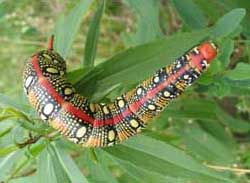 |
Hyles euphorbiae
WO/Jackson, Leafy Spurge Hawk Moth
Larvae feed on leafy spurge. Larvae are also conspicuously colored, with a
pronounced tail or "horn" near rear end.
Young larvae are variously patterned with green, yellow, and black;
older larvae have distinctive red, black, yellow, and white color
pattern. Mature larvae may approach 10 cm in length; when disturbed,
they regurgitate a slimy green liquid.
|
 |
Hyles gallii
WO/Pennington, the Bedstraw Hawk Moth
or Gallium Sphinx
This species is not reported in Chippewa, but it has been recorded in
eastern Wisconsin counties. I suspect it is present.
Larvae come in black and in brown forms and often feed on
Epilobium (fireweed).
|
 |
Hyles lineata
WO/Pennington/Bennett/Custer/Fall River, the White-lined Sphinx
Larvae are highly varied and feed on a great diversity of plants
including willow weed (Epilobium), four o'clock (Mirabilis),
apple (Malus), evening primrose (Oenothera), elm
(Ulmus), grape (Vitis), tomato (Lycopersicon),
purslane (Portulaca), and Fuschia.
All larvae seem, however, to have the red/black swellings split by
dorso-lateral lines.
|
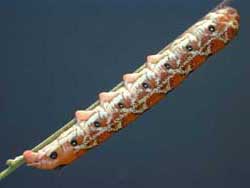 |
Newly-hatched caterpillars eat their eggshells. Larvae feed on
(Onagraceae) including evening primrose (Oenothera), gaura (Gaura),
and willow weed (Epilobium). Michael Van Buskirk has found them on
Guara biennis in Missouri. rare
|
|
|
